
Passive House Construction in West Toronto
A young family living in Toronto's west end neighborhood of Mimico, Lily, and Dennis Dittschlag and their baby boy are taking on the adventure of building a custom home. Their specifications to the builder have included a Passive House certification as a must-have requirement.

When discussing what they wanted to include in their future home, "I remembered the comfort of our family home back when I grew up in Germany," Dennis Dittschlag recalls, "And I've always missed those tilt and turn style windows." On the contrary, living in Canada with its colder winters and hotter summers, Dittschlag finds it hard to understand the types of construction used here and the challenges of achieving even temperatures and a comfortable climate in their current house. "Meanwhile, our utility bills are pretty high," Dittschlag adds and calls out the lack of energy efficiency.
The couple went on to list things that would improve the creature comforts they were looking for and optimize the energy-efficiency - like in-floor radiant heating or a tankless water heater. But it wasn't until they spent their holidays at Dittschlag's parent's newly built bungalow in northern Germany when it clicked that they needed to "think more holistically."

Related Products
Shop Related Products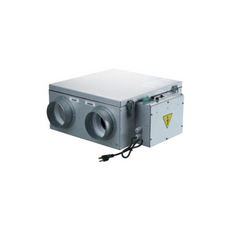
Vents Frigate Energy Recovery Ventilator
$980.00 - $1,680.00

Vents AC208EM2+LP Wall Control Panel for Frigate/Airlite Series ERVs
$265.00
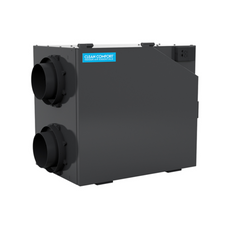
Daikin Clean Comfort VE70220 VE Series ERV
$1,487.00
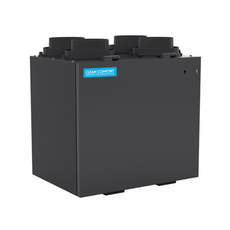
Daikin Clean Comfort VE30100 VE Series ERV
$990.00
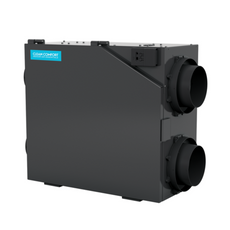
Daikin Clean Comfort VE30160 VE Series ERV
$1,322.00
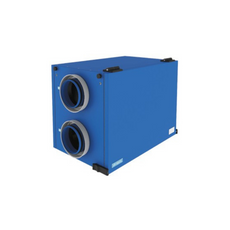
Vents Brig 120 Whole Home HRV
$1,871.00
Getting the Priorities Right
Like most people, the term "new home" initially invoked images about preferred building style and interior finishes for this family. These images are often fostered by sleek-looking homes out of magazines or TV shows. But they also wanted to think deeper: What about the basics – the home's bones and infrastructure?
Before laying out the specifications to their builder, "we asked ourselves what we most wanted out of the home to be," Dittschlag recalls. They ended up with three main priorities for their new home:
- It must be as comfortable as possible and healthy to live in, especially for a family with a young son.
- It must be worry-free at the outset and affordable in the long run; this means low operating and maintenance costs.
- It must be durable so that it remains in top shape for as long as they live there and provide optimal resale value.
In listing these priorities, it helped them focus on what they felt was essential or, as Dittschlag likes to say: "We like things done right and done for the right reasons!" A new custom home is one of the most significant investments anyone can make. As such, Dittschlag says, "it must take care of you and your family and provide the best benefits possible." Looks are nice and important, but they can be easily changed or upgraded. The basics of a house's infrastructure are much harder (and much more expensive) to upgrade down the road.
After some research into home construction concepts and standards, the couple finally landed on building a Passive House. "We also felt strongly about certifying the house," Dittschlag states, explaining that the Passive House standard is still uncommon in the new construction market in Toronto today. He also emphasizes the concept of actual performance testing instead of merely modeling a design and trusting the builder to implement a design they have never built before.
The couple admits they were uneasy about their Passive House specification at first. Still, after learning more about it and seeing it met with excitement by their builder, family, and friends, they felt encouraged in their choice.

Passive House Answers Many Questions For the Owners
When it comes to this family's priorities of comfort, financial sense, and longevity, they found that the Passive House building standard supports them all. Yes, Passive House is mostly known for the energy efficiency of a building. But, they soon found out that there are many other benefits as well.
Comfort and Well-Being:
The excellent insulation of a Passive House keeps indoor temperatures consistent, without any major swings up or down. Once dialed into your most comfortable settings, things feel good pretty much all the time. "You may not know you're in a Passive House, but you know you're comfortable," Dittschlag references. An added benefit of the insulation and the triple pane windows is better noise insulation from the exterior, too, so your house will feel rather quiet.
Passive Houses are equipped with air ventilation systems with a built-in heat exchanger. This provides a constant flow of fresh air at room temperature. The fresh air supply is not just good for all-around comfort, "but it also helps to concentrate on working at home or doing homework." Better control of the external environmental factors combined with good air filtration helps keep airborne allergens out.

Total Cost of Ownership:
At the end of the day, "we need to see a payoff over time," Dittschlag elaborates on their decision to spend extra money upfront on components and construction costs for their house. From their perspective, the formula for evaluating a Passive House is simple:
Monthly savings in operating cost + annual savings in maintenance and repair + gain in resale value altogether need to outweigh the initial investment (most likely resulting in higher monthly mortgage payments).
The savings in operating costs come from the energy efficiency of a Passive House compared to a conventional home of up to 90% improvement. By using energy-efficient appliances, LED lighting, and "good habits" of turning unused devices off, consumption can be lowered even further. And lower monthly energy consumption equals lower energy bills!
"Passive Houses are regarded as high-quality buildings," Dittschlag adds. Due to a combination of superior components in insulation, windows and doors, elimination of thermal bridges, airtightness, and an altogether better building envelope (the outer structure or shell of a house), there is less risk for moisture and mold. Hence, homeowners save on maintenance and repair costs.
The Test of Time
Applying the Passive House standard in Canada needs to be seen as a forward-looking investment. Making a home that is future proof not only complies with the current building code but far exceeds it. "It's hard to put a value on it," Dittschlag says, but a home that saves on operating cost, has a long lifespan, and meets future energy efficiency requirements will eventually shine in its equity and resale value.

Why Passive House is Right For This Family
With a Passive House, "it all comes down to doing more with less," Dittschlag quotes the Passive House Institute, "and that is a truly practical approach we can get on board with!"
For their home build, the Dittschlags are happy to proceed with the Passive House standard. It is very energy efficient and addresses their priorities of home comfort and financial savings.

Another benefit the couple mentions is how easily extendible the Passive House principles are with other sustainable building facets. Things like renewable energy systems, such as solar and geothermal, rainwater harvesting, and green roofs. As a case in point, the family committed to their builder to add a solar system on the roof for on-site renewable energy production.
The Dittschlags have made up their mind. Should they want to sell their home in the future, they feel that a certification like Passive House will only become more in-demand, especially as energy prices increase. From their point of view, they are "adding value to the property."

What They Have Learned So Far
The whole process from deciding to build a custom house to this point mid-construction has been "very exciting for these first-time custom builders," the couple states. But they admit having faced some challenges to date.
The family is working with Midnight Building Corp, a competent and experienced builder, to complete their first Passive House project. The builder has, in turn, engaged a designer and architect and a well-renowned local Passive House consultant firm. "All parties are fully on board and motivated to achieve the Passive House requirements and to build a nice house," Dittschlag explains. However, it took some time and communication efforts to figure out the construction details and how exactly certain aspects needed to be executed. Dittschlag adds that "this is amplified by remote communication needs and lead time issues of general construction material during the ongoing Covid-19 pandemic".
The family's main piece of advice can offer other homeowners and homebuilders is to start the planning and design process as early as possible. And, they say, "Make it a personal goal" of having everyone connected and on the same page.
Fortunately, they are not under time constraints to move and sell their current house. So, they can be reasonably flexible with the project schedule and are looking forward to the next months as their dream home continues taking shape on site. You can follow their adventure on their blog, Passive House Toronto.
Disclaimer: This article does not constitute a product endorsement however Rise does reserve the right to recommend relevant products based on the articles content to provide a more comprehensive experience for the reader.Last Modified: 2020-11-30T18:14:10+0000
Article by:
Lily and Dennis Dittschlag
Lily Dittschlag is from Toronto and has a career in software development and data engineering. Dennis Dittschlag grew up in Germany, where he learned about sustainability topics such as mechanical systems, renewable energy production, and recycling. Outside of their professional lives, they share a common interest in the local real estate market. Lily and Dennis Dittschlag are sharing their updates, perspectives, and challenges of their custom home, the Passive House standard, and local real estate matters on their blog and are happy to take feedback and help others.